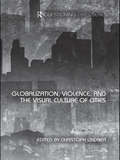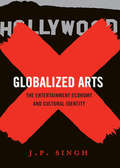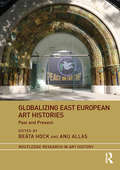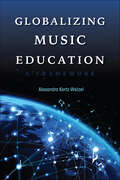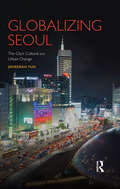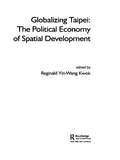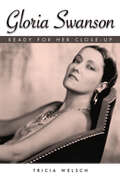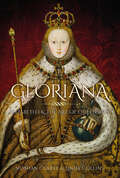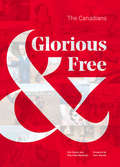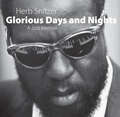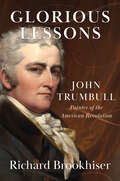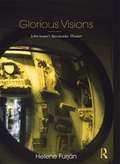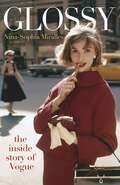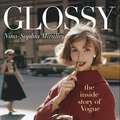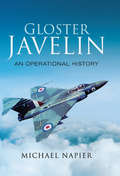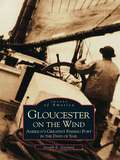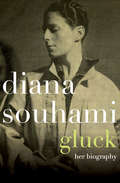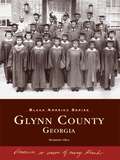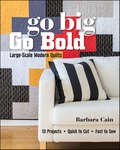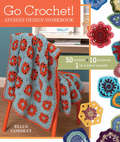- Table View
- List View
Globalization and Latin American Cinema: Towards A New Critical Paradigm (Palgrave Studies in Globalization, Culture and Society)
by Sophia A. McClennenStudying the case of Latin American cinema, this book analyzes one of the most public - and most exportable- forms of postcolonial national culture to argue that millennial era globalization demands entirely new frameworks for thinking about the relationship between politics, culture, and economic policies. Concerns that globalization would bring the downfall of national culture were common in the 1990s as economies across the globe began implementing neoliberal, free market policies and abolishing state protections for culture industries. Simultaneously, new technologies and the increased mobility of people and information caused others to see globalization as an era of heightened connectivity and progressive contact. Twenty-five years later, we are now able to examine the actual impact of globalization on local and regional cultures, especially those of postcolonial societies. Tracing the full life-cycle of films and studying blockbusters like City of God, Motorcycle Diaries, and Children of Men this book argues that neoliberal globalization has created a highly ambivalent space for cultural expression, one willing to market against itself as long as the stories sell. The result is an innovative and ground-breaking text suited to scholars interested in globalization studies, Latin-American studies and film studies.
Globalization, Violence and the Visual Culture of Cities (Questioning Cities)
by Christoph LindnerWhat connects garbage dumps in New York, bomb sites in Baghdad, and skyscrapers in São Paulo? How is contemporary visual culture – extending from art and architecture to film and digital media – responding to new forms of violence associated with global and globalizing cities? Addressing such questions, this book is the first interdisciplinary volume to examine the complex relationship between globalization, violence, and the visual culture of cities. Violence – in both material and cultural forms – has been a prominent and endemic feature of urban life in the global metropolitan era. Focusing on visual culture and offering a strong humanities perspective that is currently lacking in existing scholarship, this book seeks to understand how the violent effects of globalization have been represented, theorized, and experienced across a wide range of cultural contexts and urban locations in Asia, Europe, North and South America, and the Middle East. Organized around three interrelated themes – fear, memory, and spectacle – essay topics range from military targeting in Baghdad, carceral urbanism in São Paulo, and the Paris banlieue riots, to the security aesthetics of G8 summits, the architecture of urban paranoia, and the cultural afterlife of the Twin Towers. Globalization, Violence, and the Visual Culture of Cities offers fresh insight into the problems and potential of cities around the world, including Beijing, Berlin, London, New York, Paris, and São Paulo. With specially-commissioned essays from the fields of cultural theory, architecture, film, photography, and urban geography, this innovative volume will be a valuable resource for students, scholars, and researchers across the humanities and social sciences.
Globalized Arts: The Entertainment Economy and Cultural Identity
by J. P. SinghOur interactive world can take a cultural product, such as a Hollywood film, Bollywood song, or Latin American telenovela, and transform it into a source of cultural anxiety. What does this artwork say about the artist or the world she works in? How will these artworks evolve in the global market? Film, music, television, and the performing arts enter the same networks of exchange as other industries, and the anxiety they produce informs a fascinating area of study not only for art and culture but also for global politics. Focusing on the confrontation between global politics and symbolic creative expression, J. P. Singh shows how, by integrating themselves into international markets, entertainment industries give rise to far-reaching cultural anxieties. With examples from Hollywood, Bollywood, French grand opera, Latin American television, West African music, postcolonial literature, and even the Thai sex trade, Singh cites both the attempt to address cultural discomfort and the effort to deny entertainment acts as cultural. He connects creative expression to clashes between national identities, and he details the effect of cultural policies, such as institutional patronage and economic incentives, on the making and incorporation of art into the global market. Ultimately, Singh shows how these issues impact the debates on cultural trade being waged by the World Trade Organization, UNESCO, and the developing world.
Globalized Arts: The Entertainment Economy and Cultural Identity
by J. P. SinghOur interactive world can take a creative product, such as a Hollywood film, Bollywood song, or Latin American telenovela, and transform it into a source of cultural anxiety. What does this artwork say about the artist or the world she works in? How will these artworks evolve in the global market? Film, music, television, and the performing arts enter the same networks of exchange as other industries, and the anxiety they produce informs a fascinating area of study for art, culture, and global politics.Focusing on the confrontation between global politics and symbolic creative expression, J. P. Singh shows how, by integrating themselves into international markets, entertainment industries give rise to far-reaching cultural anxieties and politics. With examples from Hollywood, Bollywood, French grand opera, Latin American television, West African music, postcolonial literature, and even the Thai sex trade, Singh cites not only the attempt to address cultural discomfort but also the effort to deny entertainment acts as cultural. He connects creative expression to clashes between national identities, and he details the effect of cultural policies, such as institutional patronage and economic incentives, on the making and incorporation of art into the global market. Ultimately, Singh shows how these issues affect the debates on cultural trade being waged by the World Trade Organization, UNESCO, and the developing world.
Globalizing East European Art Histories: Past and Present (Routledge Research in Art History)
by Beáta Hock Anu AllasThis edited collection reassesses East-Central European art by offering transnational perspectives on its regional or national histories, while also inserting the region into contemporary discussions of global issues. Both in popular imagination and, to some degree, scholarly literature, East-Central Europe is persistently imagined as a hermetically isolated cultural landscape. This book restores the diverse ways in which East-Central European art has always been entangled with actors and institutions in the wider world. The contributors engage with empirically anchored and theoretically argued case studies from historical periods representing notable junctures of globalization: the early modern period, the age of Empires, the time of socialist rule and the global Cold War, and the most recent decades of postsocialism understood as a global condition.
Globalizing Music Education: A Framework (Counterpoints: Music and Education)
by Alexandra Kertz-WelzelHow do globalization and internationalization impact music education around the world? By acknowledging different cultural values and priorities, Alexandra Kertz-Welzel's vision challenges the current state of international music education and higher education, which has been dominated by English-language scholarship. Her framework utilizes an interdisciplinary approach and emphasizes the need for developing a pluralistic mode of thinking, while underlining shared foundations and goals. She explores issues of educational transfer, differences in academic discourses worldwide, and the concept of the global mindset to help facilitate much-needed transformations in global music education. This thinking and research, she argues, provides a means for better understanding global transfers of knowledge and ways to avoid culturally and linguistically hegemonic standards. Globalizing Music Education: A Framework is a timely call to action for a more conscious internationalization of music education in which everyone can play a part.
Globalizing Seoul: The City's Cultural and Urban Change (Planning, History and Environment Series)
by Jieheerah YunIn the decades following the 1997 Asian economic crisis, South Korea sought segyehwa (globalization). Evidence of this is no more evident than in the country’s capital, Seoul, where urban development has been central to making the city a global hub and not just the centre of the national economy. However, recent development projects differ from those of the past in that they no longer focus solely on economic efficiency, but on the deployment of a new urban aesthetics. As Jieheerah Yun reveals in Globalizing Seoul: The City’s Cultural and Urban Change, the pursuit of globalization and the rebranding of Seoul’s image from hard industrial city to soft cultural city have shaped the urban development of the city. Following a brief urban history of Seoul, she focuses on two key themes. In the first, how globalization has contributed to refashioning Korean traditions, she analyzes the policies and actions to preserve Korean folk houses and pre-industrial street layouts, looking in detail at the Bukchon and Insadong areas of the city. Her second theme is an examination of migration and the generation of new minority neighbourhoods amidst the segyehwa policies and the state’s efforts to build a multicultural society. In detailed case studies of the redevelopment of Dongdaemun Market as part of rebranding Seoul as the ‘world design capital’ and of the Itaewon area as both a Special Tourist Zone and a Global Cultural Zone, she shows how multi-ethnic neighbourhoods are threatened by lack of consideration for economic justice and housing provision.
Globalizing Taipei: The Political Economy of Spatial Development (Planning, History and Environment Series)
by Reginald Yin-Wang KwokTaipei's quest to become a global city is the key to its urban development. Globalizing Taipei looks at this "Asian Dragon", a major city in the South China Growth Triangle and a centre for transnational production, revealing how the development of this capital has received firm state support but is conditioned by international and domestic politics.The book is divided into four parts: economic and spatial restructuring, state and society realignment, social differentiation and cultural reorientation. Each analyzes the interaction of international, state and local politics in the shaping of the city's urban environment since World War II.All contributors to this edited volume are Taiwan scholars presenting critical insiders' views. Based on each author's specialization and research focus, each chapter provides an in-depth consideration of one of Taipei's developmental issues generated by globalization. Collectively they provide broad, insightful and coherent coverage of this crucial time in Taipei's global transmutation.
Gloria Swanson: Ready for Her Close-Up (Hollywood Legends Series)
by Tricia WelschGloria Swanson: Ready for Her Close-Up shows how a talented, self-confident actress negotiated a creative path through seven decades of celebrity. It also illuminates a little-known chapter in American media history: how the powerful women of early Hollywood transformed their remarkable careers after their stars dimmed. This book brings Swanson (1899–1983) back into the spotlight, revealing her as a complex, creative, entrepreneurial, and thoroughly modern woman. Swanson cavorted in slapstick short films with Charlie Chaplin and Mack Sennett in the 1910s. The popularity of her films with Cecil B. DeMille helped create the star system. A glamour icon, Swanson became the most talked-about star in Hollywood, earning three Academy Award nominations, receiving 10,000 fan letters every week, and living up to a reputation as Queen of Hollywood. She bought mansions and penthouses, dressed in fur and feathers, and flitted through Paris, London, and New York engaging in passionate love affairs that made headlines and caused scandals. Frustrated with the studio system, Swanson turned down a million-dollar-a-year contract. After a wild ride making unforgettable movies with some of Hollywood’s most colorful characters—including her lover Joseph Kennedy and maverick director Erich von Stroheim—she was a million dollars in debt. Without hesitation she went looking for her next challenge, beginning her long second act. Swanson became a talented businesswoman who patented inventions and won fashion awards for her clothing designs; a natural foods activist decades before it was fashionable; an exhibited sculptor; and a designer employed by the United Nations. All the while she continued to act in films, theater, and television at home and abroad. Though she had one of Hollywood’s most famous exit lines—"All right, Mr. DeMille, I’m ready for my close-up!”—the real Gloria Swanson never looked back.
Gloriana: Elizabeth I and the Art of Queenship
by Siobhan Clarke Linda CollinsIn a Reformation kingdom ill-used to queens, Elizabeth I needed a very particular image to hold her divided country together. The ‘Cult of Gloriana’ would elevate the queen to the status of a virgin goddess, aided by authors, musicians, and artists such as Spenser, Shakespeare, Hilliard, Tallis and Byrd. Her image was widely owned and distributed, thanks to the expansion of printing, and the English came to surpass their European counterparts in miniature painting, allowing courtiers to carry a likeness of their sovereign close to their hearts.Sumptuously illustrated, Gloriana: Elizabeth I and the Art of Queenship tells the story of Elizabethan art as a powerful device for royal magnificence and propaganda, illuminating several key artworks of Elizabeth’s reign to create a portrait of the Tudor monarch as she has never been seen before.
Glorious & Free: The Canadians
by Rita Field-Marsham Kim Bozak33 personal stories that redefine how Canadians see themselves.We are more than just landscapes, polar bears, Mounties, and canoes. More than just “thank yous,” “sorrys,” hot prime ministers, and doughnut shops. We are also tattoo artists who have discovered the secret to cheating death. Designers hell-bent on winning the Nobel Peace Prize. Super soldiers who take “live vests” off suicide bombers. Freethinkers who refuse to be tamed. We are global-village visionaries, world record setters, ambassadors of the imagination, and conquerors of the Rockies. We are Canadian. We are whoever we dream ourselves to be. Meet the glorious and free.$2 from each book sale will be donated to PEN Canada in support of its efforts to defend freedom of expression. Why? Because living glorious and free involves challenging, exploring, and imagining a better world — and being whoever we dream ourselves to be. And freedom of expression protects our right to do all of that.
Glorious Days and Nights: A Jazz Memoir
by Herb SnitzerGlorious Days and Nights is a personal account of the fifty-year career of jazz photographer Herb Snitzer, with a special focus on his years in New York City from 1957 to 1964. A photojournalist for Life, Look, and Fortune, Snitzer was the photo editor and later associate editor of the influential jazz magazine Metronome. During the 1960s, politics, race, and social strife and unrest swirled in Snitzer's life as a working artist. But throughout the bus boycotts, demonstrations, civil and racial unrest, what remained constant for him was jazz. Snitzer recalls what it was like to go on the road with these musicians. His reflections run the gamut from serious meditations on his development as a young photographer working with musicians already of great stature to more conversational recollections of casual moments spent having fun with the jazz artists many of whom became close friends. This book includes Snitzer's very best jazz photographs. He reveals the essences of the artists, their struggles, joys, and pains. A number of Snitzer's jazz images have become iconic, including Louis Armstrong with the Star of David, Lester Young at The Five Spot Café in New York City, John Coltrane reflected in a mirror, Thelonious Monk with piano keys reflected in his sunglasses, and Miles Davis at Newport. With eighty-five black-and-white images of jazz giants, Glorious Days and Nights provides a long-awaited testimony to the friendships and artistry that Snitzer developed over his remarkable career.
Glorious Lessons: John Trumbull, Painter of the American Revolution
by Richard BrookhiserThe complicated life and legacy of John Trumbull, whose paintings portrayed both the struggle and the principles that distinguished America&’s founding moment &“Succinct, both scholarly and direct. . . . Wonderful art history.&”—Brian T. Allen, National Review John Trumbull (1756–1843) experienced the American Revolution firsthand—he served as aid to George Washington and Horatio Gates, was shot at, and was jailed as a spy. He made it his mission to record the war, giving visual form to what most citizens of the new United States thought: that they had brought into the world a great and unprecedented political experiment. His purpose, he wrote, was &“to preserve and diffuse the memory of the noblest series of actions which have ever presented themselves in the history of man.&” Although Trumbull&’s contemporaries viewed him as a painter, Trumbull thought of himself as a historian. Richard Brookhiser tells Trumbull&’s story of acclaim and recognition, a story complicated by provincialism, war, a messy personal life, and, ultimately, changing fashion. He shows how the artist&’s fifty-year project embodied the meaning of American exceptionalism and played a key role in defining the values of the new country. Trumbull depicted the story of self-rule in the modern world—a story as important and as contested today as it was 250 years ago.
Glorious Mud!: Ancient and Contemporary Earthen Design and Construction in North Africa, Western Europe, the Near East, and Southwest Asia (Smithsonian Contributions to Knowledge)
by Ora Van Beek Gus W. Van BeekInvented about 13,000 years ago, mud architecture has since been one of the most common, economical, useful, and widespread forms of building. It has been--and is still being--used for grand palaces and temples as well as simple shops and homes. Research conducted over the last several decades has enabled archaeologists and architects to understand how now-ruined, ancient mud structures were originally built. Gus and Ora Van Beek describe mud-construction techniques from Southwest Asia, the Near East, North Africa, Europe, and the United States, paying specific attention to problems involving foundations, wall and roof construction, cooling and heating, water erosion, and earthquake damage. Glorious Mud! is not only the definitive reference work on one of the world's most important forms of architecture but also a powerful study of the human past.
Glorious Visions: John Soane's Spectacular Theater
by Helene FurjánFocusing on the house and museum and its considerable collections of architectural fragments, models, drawings folios and publications, this book is about thirteen Lincoln’s Inn Fields in London, England, built in the early 1800s by the renowned eighteenth-century architect Sir John Soane. The book maps the influences, references, connections, extensions, and productions at play in Soane’s house-museum. The house, still a public museum, was highly original in its period, and it continues to influence and impress architects and historians alike. Today’s visitor is confronted by a dense, complex series of spaces, a strange accumulation of rooms, objects and effects. This book examines the ways in which Soane enlisted light, shadow, color, fiction and narrative, vistas, spatial complexity, the fragment, and the mirror to produce a spectacular space.
Glory in a Line: A Life of Foujita, the Artist Caught Between East & West
by Phyllis BirnbaumThe first biography in English of the Japanese artist who was a central figure in the dazzling artistic milieu of 1920s ParisWhen we think of expatriates in Paris during the early decades of the twentieth century, certain names come to mind: Hemingway, Picasso, Modigliani—and Foujita, the Japanese artist whose distinctive works, bringing elements of Japanese art to Western oil painting, made him a major cultural figure in 1920s Montparnasse. Foujita was the only Japanese artist to be considered part of the "School of Paris," which also counted among its members such prominent artists as Picasso and Modigliani. Noteworthy, too, was Foujita's personal style, flamboyant even for those flamboyant times. He was best known for his drawings of female nudes and cats, and for his special white color upon which he could draw a masterful line—one that seemed to outline a woman's whole body in a single unbroken stroke. With the advent of the Second World War, Foujita returned to Japan, where he allied himself with the ruling Japanese militarists and painted canvases in support of the war effort. After Japan's defeat, he was scorned for his devotion to the military cause and returned to France, where he remained until his death in 1968. Acclaimed writer and translator Phyllis Birnbaum not only explores Foujita's fascinating, tumultuous life but also assesses the appeal of his paintings, which, in their mixture of Eastern and Western traditions, are memorable for their vibrancy of form and purity of line.
Glossy: The inside story of Vogue
by Nina-Sophia Miralles'Dame Anna Wintour might be one of the best-known and most successful journalists on the planet. But it wasn't always like that. When she started out on Vogue she was often so miserable she had to phone her husband for help. This is just one of countless fascinating titbits in this zippy story of dizzying fortune, out-of this-world fashion, ingenuity, passion, sex and power.And, this being fashion, some intense bitchiness too. Started as a gossip magazine for snobbish New Yorkers in 1892, Vogue is now one of the most recognisable brands in the world. Spanning London, New York and Paris, this is a high-speed, fun read full of fascinating though not always likeable people.' Daily MailGlossy is a story of more than a magazine. It is a story of passion and power, dizzying fortune and out-of-this-world fashion, of ingenuity and opportunism, frivolity and malice. This is the definitive story of Vogue.Vogue magazine started, like so many great things do, in the spare room of someone's house. But unlike other such makeshift projects that flare up then fizzle away, Vogue burnt itself onto our cultural consciousness. Today, 128 years later, Vogue spans 22 countries, has an international print readership upwards of 12 million and nets over 67 million monthly online users. Uncontested market leader for a century, it is one of the most recognisable brands in the world and a multi-million dollar money-making machine. It is not just a fashion magazine, it is the establishment. But what - and more importantly who - made Vogue such an enduring success?Glossy will answer this question and more by tracing the previously untold history of the magazine, from its inception as a New York gossip rag, to the sleek, corporate behemoth we know now. This will be a biography of Vogue in every sense of the word, taking the reader through three centuries, two world wars, plunging failures and blinding successes, as it charts the story of the magazine and those who ran it.
Glossy: The inside story of Vogue
by Nina-Sophia Miralles'Dame Anna Wintour might be one of the best-known and most successful journalists on the planet. But it wasn't always like that. When she started out on Vogue she was often so miserable she had to phone her husband for help. This is just one of countless fascinating titbits in this zippy story of dizzying fortune, out-of this-world fashion, ingenuity, passion, sex and power.And, this being fashion, some intense bitchiness too. Started as a gossip magazine for snobbish New Yorkers in 1892, Vogue is now one of the most recognisable brands in the world. Spanning London, New York and Paris, this is a high-speed, fun read full of fascinating though not always likeable people.' Daily MailGlossy is a story of more than a magazine. It is a story of passion and power, dizzying fortune and out-of-this-world fashion, of ingenuity and opportunism, frivolity and malice. This is the definitive story of Vogue.Vogue magazine started, like so many great things do, in the spare room of someone's house. But unlike other such makeshift projects that flare up then fizzle away, Vogue burnt itself onto our cultural consciousness. Today, 128 years later, Vogue spans 22 countries, has an international print readership upwards of 12 million and nets over 67 million monthly online users. Uncontested market leader for a century, it is one of the most recognisable brands in the world and a multi-million dollar money-making machine. It is not just a fashion magazine, it is the establishment. But what - and more importantly who - made Vogue such an enduring success?Glossy will answer this question and more by tracing the previously untold history of the magazine, from its inception as a New York gossip rag, to the sleek, corporate behemoth we know now. This will be a biography of Vogue in every sense of the word, taking the reader through three centuries, two world wars, plunging failures and blinding successes, as it charts the story of the magazine and those who ran it.
Glossy: The inside story of Vogue
by Nina-Sophia MirallesGlossy is a story of more than a magazine. It is a story of passion and power, dizzying fortune and out-of-this-world fashion, of ingenuity and opportunism, frivolity and malice. This is the definitive story of Vogue.Vogue magazine started, like so many great things do, in the spare room of someone's house. But unlike other such makeshift projects that flare up then fizzle away, Vogue burnt itself into our cultural consciousness. Today, 125 years later, Vogue spans 22 countries, has an international print readership upwards of 12 million and nets over 67 million monthly online users. Uncontested market leader for a century, it is one of the most recognisable brands in the world and a multi-million dollar money-making machine. It is not just a fashion magazine, it is the establishment. But what - and more importantly who - made Vogue such an enduring success?Glossy will answer this question and more by tracing the previously untold history of the magazine, from its inception as a New York gossip rag, to the sleek, corporate behemoth we know now. This will be a biography of Vogue in every sense of the word, taking the reader through three centuries, two world wars, plunging failures and blinding successes, as it charts the story of the magazine and those who ran it.(P)2020 Quercus Editions Limited
Gloster Javelin: An Operation History
by Michael NapierThe RAFs only delta-winged fighter the Gloster Javelin was also Britains first true All-Weather Fighter. Based in the UK and in Germany, the RAFs Javelin squadrons formed the front line of Britains air defences in the late 1950s and early 1960s. During this time Javelin crews pioneered the operational use of guided missiles and air-to-air refuelling by fighter aircraft. In the Far East, Javelins were involved in operations during the Indonesian Confrontation and the aircraft was also deployed to Zambia during the Rhodesian UDI Crisis. In this history, which is richly illustrated with many previously unpublished photographs, Michael Napier blends official records with personal accounts to describe the operational history of this iconic jet fighter.
Gloucester on the Wind: America's Greatest Fishing Port in the Days of Sail (Images of America)
by Joseph E. GarlandSince the development of photography in the mid-nineteenth century, the camera has been used as a tool of both discovery and preservation. Photographs bring alive our image of the past, and can open a floodgate of memories and nostalgia or inspire curiosity and a sense of history. Originally founded by a fishing company from Dorchester, England, in 1623, Gloucester has always been linked to fishing and the sea. By 1870 Gloucester was the leading fishing port in the Western Hemisphere, and its great fleet of fast, white-winged schooners ranged deep into the heart of the Atlantic in search of cod, haddock, halibut, and mackerel. These stunningly beautiful ships and the hardy men who sailed them made "Gloucester" an evocation of courage, perseverance, and seamanship unique in America's maritime heritage.
Gluck: Her Biography
by Diana SouhamiDiana Souhami&’s critically acclaimed biography of lesbian painter Hannah Gluckstein—the woman, the artist, the legend To her family, Hannah Gluckstein was known as Hig. To Edith Shackleton Heald, the journalist with whom she lived for almost forty years, she was Dearest Grub. And to the art world, she was simply Gluck. She was born in 1895 into a life of privilege. Her family had founded J. Lyons & Co., a vast catering empire. From the beginning Gluck was a rebel. At a time when only men wore trousers, she scandalized society with her masculine clothing—though she always dressed with style and turned androgyny into high fashion. Her affairs with high-profile women shocked her conservative family, even while she achieved fame as an artist. During the 1920s and thirties, Gluck&’s paintings—portraits, flowers, and landscapes, presented in frames designed and patented by her—were the toast of the town. At the height of her success, when wounded in love, her own obsessions caused her to fade for decades from the public eye, but then, at nearly eighty, her return to the spotlight ensured her immortality.
Glynn County, Georgia (Black America Series)
by Benjamin AllenGlynn County's African-American citizenry has left an indelible mark on the history of Georgia as well as the nation. Such notable figures as Dr. Charles Wesley Buggs, renowned microbiologist; Robert Sengstacke Abbott, founder of the Chicago Defender; and Marilyn Moore Brown, an internationally praised opera singer have emerged from this picturesque coastal community. Numerous others have achieved success in education, medicine, sports, and the arts. Their engaging stories of triumph and the legacy they have created are celebrated and preserved in this unique volume.
Go Big, Go Bold: Large-Scale Modern Quilts
by Barbara CainBig-block quilts to whip up this weekend A quilt in one weekend! Indulge in your favorite hobby when you piece graphic, bold blocks. Well-known blogger Barbara Cain invites you make simple patchwork scaled to dynamic proportions, so pattern pieces are quicker to cut and easier to sew. Each of the 10 beginner-friendly, big-block quilt designs features 2 sizes and 6 colorways for 120 striking possibilities! Use elements from the quilt top to make a coordinating pieced quilt back. Maximize your time when you make and gift these modern quilts, which can be assembled in a weekend. • 10 graphic, large-scale quilt patterns that are quick to sew, even for beginners • Staggering variety! Customize each quilt with 2 sizes and 6 colorways per project, for 120 possibilities • Creative pieced quilt backs carry over design elements from each quilt top
Go Crochet! Afghan Design Workshop: 50 Motifs, 10 Projects, 1 of a Kind Results
by Ellen GormleyTake your crochet on the go! Do your hands itch to crochet while you sit in waiting rooms, on airplanes and at soccer games, but you don't want to carry along lots of yarn and heavy projects? In Go Crochet! Afghan Design Workbook, you'll find patterns for 50 interchangeable motifs designed for a range of skill levels that can be easily crocheted while on the go! Author Ellen Gormley provides you with great tips for assembling portable projects, creating fantastic color combinations, and arranging your crocheted motifs in unique and exciting ways. Inside, you'll find: Patterns and stitch diagrams for 50 motifs in 5 different shapes: squares, rectangles, triangles, hexagons and octagons Recommendations from the author for 5 great mix-and-match options for each interchangeable motif 10 complete afghan patterns using a single motif, 2-3 motifs and multiple motifs A thorough guide to crochet basics, as well as design techniques for assembling your motifs into one-of-a-kind projects So choose your favorite motif, grab your hook and yarn, and go crochet!

